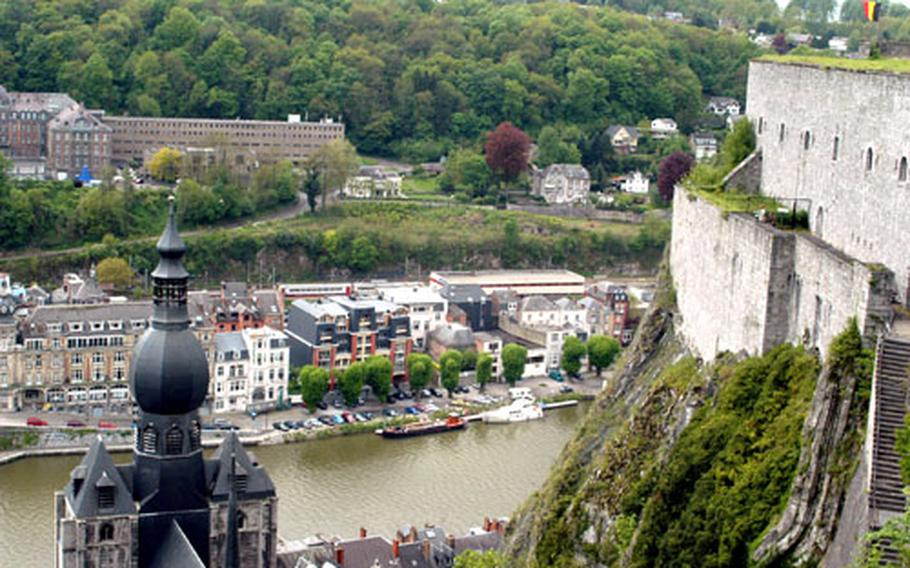
Dinant Citadel was built in the Middle Ages to dominate the Meuse River. (Russ Rizzo / S&S)
The tiny, French-speaking Belgian border town of Dinant along the Meuse River boasts one tourist attraction to speak of: its restored fortress.
Built in 1040 to control activities along the river, the Dinant Citadel has a long history of conquests and destruction that is humorously laid out in a series of displays inside the building — displays that border on the absurd.
Beyond the picturesque, one-minute cable-car ride to the citadel from the town center below, and a unique balancing test conducted during the guided tour, the exhibits are perhaps the only things that make a trip to the old fortress worth the 40-minute drive from Brussels.
You get a sense early on that those making the exhibit were having a little fun with their craft.
Take the display depicting Charles the Bold’s sacking of Dinant in 1466: A life-size ceramic Charles stands triumphantly in the foreground wearing a cape, thigh-high black leather boots and a red blouse with matching turban.
Behind him, two people tied together by rope are falling to sure death in a scene that would steal chuckles if it didn’t reflect actual, tragic events. As the display says, 800 people were killed during the conquest.
Laughs do break out over the model kitchen, though, as observant tourists notice a headless rubber chicken on a cutting board and a boar hanging from the ceiling dripping fake blood into a pan with a knife still planted in its stomach. Mice in flour pans of a bakery at the next display are a nice touch, too.
The one-hour tour is the only way visitors are allowed to see the citadel, which is a shame because it is offered only in French and tediously slow. Don’t hope for any English translation, either, as anyone talking while the tour guide speaks is quickly shushed.
The tour is worth following to the explosive end. Visitors are taken to a basement lined with sandbags where mock gunfire plays from overhead speakers. Uneven cobblestone floors that lie at a nearly 45-degree angle test visitors’ balance and are perhaps the highlight of the experience.
The timeline offered in the citadel’s courtyard offers a glimpse at the fortress’ interesting history. The Cliffs Notes version: Built in 1040; destroyed in 1466; rebuilt in 1523; occupied by the king of France in 1554; seized by Louis XIV in 1675; taken over by newly created Kingdom of Belgium in 1830; occupied by Germans in World War I; occupied again by the Germans in World War II; liberated in 1944; tourist attraction ever sense.
Having a hard time finding wooden swords, jousting sticks and double-balled maces (traditional steel balls replaced by pillows) for the kids? Look no further than the citadel’s gift shop.
A cafeteria also operates at the top of the hill next to the citadel, offering reasonable prices and a nice view.
Travelers might be interested in the larger and more popular citadel in nearby Namur along the Meuse. But arrive prepared to walk: Its cable car station burned down about five years ago.
On the QT ...
DIRECTIONS: The citadel is on the top of a hill just above the center of town. The entrance to the cable car and stairs lies behind the main church.
It is best reached by car by taking highway A4 toward Ring/Namur, and then Exit 20 toward Phillipville/Dinant. A4 can be reached from Mons by traveling east on A15, and from the Maastricht area by going south on A13 and then west on A15.
COSTS: Admission for adults is 5.50 euros, and for children 4 euros.
TIMES: The citadel is open 10 a.m. to 6 p.m. daily from April to October; 10 a.m. to 5 p.m. all days but Friday from November to March; and on weekends and holidays from 10 a.m. to 5 p.m. in January.
FOOD: There is a restaurant at the end of the cable-car route next to the citadel. Best bet may be a picnic from the offerings of several small shops that sell meat and side dishes.
INFORMATION: The citadel’s official Web site.
— Russ Rizzo